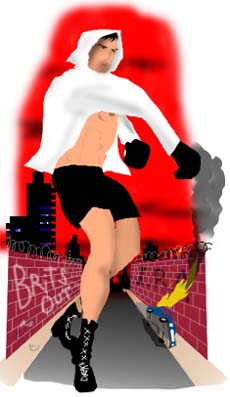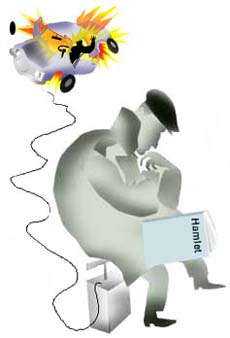The Luck of the Irish
In the movies, IRA terrorists become dashing heroes.

Typically, setting off bombs in crowded places doesn't make you a hero in Hollywood, although it might well win you a supporting role as a villain. But the rules are different for the Irish Republican Army, which has been bombing civilian targets in Great Britain for 25 years. While the movies routinely turn other terrorists into gun fodder for the likes of Arnold Schwarzenegger, IRA crusaders almost always play the role of the tragic, troubled, and ultimately noble Good Guy.
Take some recent cinematic excursions into the Troubles. November's The Jackal featured Richard Gere as a former IRA sharpshooter--not bomber--let out of prison to stop a mercenary terrorist, played by Bruce Willis. Gere is a virtuous hero throughout, so much so that at the film's end, the authorities blithely grant him his freedom. Similarly, last year's The Devil's Own gave us Brad Pitt confronting corrupt gangsters and dying a romantic death for the Ireland he loved. And Neil Jordan's Michael Collins (1996) sympathetically portrayed Collins and his comrades in the 1918-1921 Irish war for independence from Britain--a war won in part by Collins' strategy of bombings and late-night assassinations.
The latest of the free-Ireland films, Jim Sheridan's The Boxer, features Daniel Day-Lewis as a former IRA member weary of violence after 14 years in prison. This film is more sophisticated than the others, and it explicitly condemns violence in a way most IRA films don't. But it, too, draws careful distinctions between "bad" terrorists, represented by a rogue IRA agent who tries to murder Day-Lewis, and "good" terrorists, represented by the IRA leadership, which tries to protect him.
We are talking about Hollywood, of course, which means that violence--particularly political violence--must be repudiated in the end. So nearly every IRA film concludes with the hero's death (as both Michael Collins and The Devil's Own do). Most also pay lip service to the idea that murder is not the solution to political problems, generally by making the hero a regretful killer who wishes he could just put down the gun. Yet all these films are suffused with a sense of the basic justice of the Irish nationalist cause and, more than that, of the purity of the motives that drive the IRA. Members are portrayed as ascetic and hard-nosed, men you can respect even if you don't agree with them. In another Sheridan-Day-Lewis collaboration, In the Name of the Father (1993), in which Day-Lewis plays a man framed for an IRA bombing, the one person in prison who stands for authority and justice is an IRA leader. In The Jackal, characters refer to Gere's "passion" and "fire," in explicit contrast to the chill cynicism of Willis, whose only cause is money.
Even when Irish terrorists do seem indiscriminately violent or crazy, it turns out the IRA isn't to blame. In Patriot Games (1992), militants try to kill Harrison Ford and his family; in Blown Away (1994), a lunatic IRA man sets off bombs all over Boston; and in The Boxer, the rogue agent kills an old man, beats women, and bombs pubs. Yet in every case, the villains are not true IRA members but loose cannons who have broken away from the organization. The IRA doesn't favor random terrorist activity; splinter groups do.

T his is a distortion, of course. Since at least 1970, the IRA has supported plenty of random terrorist activity in its quest to reunify British-controlled Northern Ireland with independent Ireland. Northern Ireland was split off from the rest of the country in 1921, as part of the peace agreement that ended the Irish war for independence (an agreement negotiated by Michael Collins). For nearly five decades after that, the IRA existed only as a shadowy fringe group. But the turmoil of the 1960s, during which a movement for Catholic civil rights led to sectarian violence, brought the IRA back into the limelight. When British paratroopers gunned down 13 peace marchers in Derry in 1972, the IRA inaugurated a new campaign of violence.
Since the Protestant majority in Northern Ireland wants to remain a part of Great Britain, and since Ireland itself has shown little interest in reunification, the IRA's prospects for success through political channels have always been limited. Instead, it has pursued a strategy designed to make the British presence in Northern Ireland too costly for the British public to endure. Bombing the Grand Hotel in Brighton, mortaring Heathrow Airport, and setting off bombs on the London docks were actions meant to remind the British of what was happening in Belfast. In recent years, the IRA has shown a greater interest in solutions short of reunification. It obeyed a cease-fire between August 1994 and February 1996 and agreed to another last July. But the organization has never repudiated the use of terrorism or the targeting of civilians.
So why does Hollywood give the IRA this special treatment? First, there's the appeal, to Americans, of the Irish--or, at least, of our idea of Irishness. Americans imagine the striving, suffering Irishwomen and the hard-drinking, hard-fighting, working-class Irishmen to be the sort of people who founded, and now form the backbone of, our own country. IRA heroes look and sound enough like Americans--that is, like white Americans--to make visceral identification a snap. Aside from race, after all, it's hard to imagine why IRA members make more sympathetic heroes than members of the African National Congress. IRA members aren't living in camps in the desert, either. Instead, they're hiding in familiar-looking homes and running down familiar-looking streets. And they're speaking a dialect of English that's distinctly similar--a precursor, in fact--to ours.
The films also build upon the long history of popular American support for Irish independence. As far back as the mid-19th century, the Fenian movement for Irish independence was funded mainly through American contributions. Irish-Americans provided crucial financial support for the 1918-1921 war against Britain that created the Free State. (In Michael Collins, Collins steals his best friend's girlfriend when the friend goes to America to raise money.) Since 1969, Irish-Americans have been probably even more fervent in their support for the IRA than have the Irish themselves.
T he IRA's tactics also happen to be well suited to the conventions of Hollywood cinema. Because its campaigns tend to involve the planning and execution of individual acts rather than all-out warfare, IRA members look and act more like professional criminals than like revolutionaries. For plot construction, this is a big plus--something Hollywood has recognized in pro-IRA films dating back to John Ford's The Informer (1935) and Carol Reed's Odd Man Out (1947). The scenes of planning terrorist operations in Odd Man Out, The Devil's Own, and Jordan's The Crying Game (1992) are almost identical to the scenes in gangster films like The Killing (1956) and The Asphalt Jungle (1950), where the hoodlums carefully put together their capers. Moviegoers love the intricacies of a crime, all the more when it's for a good cause.
Finally, the simplistic view of politics that animates the IRA fits neatly with the conventional narrative structures that Hollywood adores. Real politics is messy and morally ambiguous and doesn't make for a compelling thriller. But the black-and-white world of the true believer does, especially when it's festooned with the trappings of Irish romanticism. The IRA, you might say, already lives in a Hollywood movie, with its noble heroes, amoral enemies, and glorious deaths. It's no surprise that moviemakers figured that out.